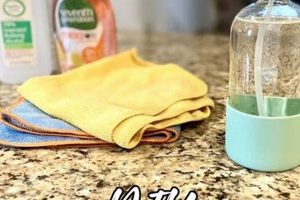A self-constructed enclosure designed to conceal and enhance the aesthetic appeal of a kitchen ventilation system. This structure, typically built from wood or metal, encases the functional components of the system, such as the fan and ductwork, while providing a decorative exterior. As an example, a homeowner might construct a wooden frame around an existing metal vent, staining it to match the kitchen cabinetry.
Creating such a feature offers several advantages. It allows for customization to match the overall design scheme of the kitchen, masking utilitarian aspects with a more visually pleasing element. Furthermore, it can increase property value by contributing to a cohesive and well-designed kitchen space. Historically, these enhancements evolved from simple, functional coverings to elaborate architectural statements, reflecting changing trends in interior design and a greater emphasis on kitchen aesthetics.
The subsequent sections will delve into material selection, construction techniques, and design considerations for building these kitchen enhancements, providing a guide for those interested in undertaking such a project.
Construction and Design Considerations
The following are essential guidelines to observe when planning and executing the construction of a custom kitchen ventilation enclosure. These guidelines address safety, functionality, and aesthetic considerations.
Tip 1: Material Selection: Choose materials that are both aesthetically compatible with the existing kitchen dcor and resistant to heat and moisture. Solid wood, plywood with a durable veneer, and certain metals are appropriate choices. Ensure any wood product is sealed appropriately to prevent moisture damage.
Tip 2: Ventilation Requirements: Maintain adequate clearance around the ventilation unit to ensure proper airflow and prevent overheating. Consult the manufacturer’s specifications for recommended clearances. Modification of the existing system’s ventilation capabilities is not advisable.
Tip 3: Code Compliance: Verify local building codes regarding fire safety and ventilation. Certain materials may be prohibited near heat sources, and specific requirements for exhaust ducting may exist. Adherence to codes is mandatory to ensure safety and legal compliance.
Tip 4: Structural Integrity: Design a structure that is robust and capable of supporting its own weight. Securely attach it to the wall or ceiling using appropriate fasteners and anchors. A poorly constructed enclosure can pose a safety hazard.
Tip 5: Accessibility for Maintenance: Incorporate removable panels or doors to allow access to the ventilation unit for cleaning, repairs, and filter replacement. Ease of access will prolong the life of the appliance and facilitate necessary maintenance.
Tip 6: Surface Finishing: Apply a durable, heat-resistant finish to the completed enclosure. Paint, stain, or varnish should be suitable for kitchen environments and easy to clean. A quality finish will protect the material and enhance its appearance.
Tip 7: Lighting Integration: Consider incorporating task lighting into the enclosure to improve visibility of the cooking surface. Recessed lighting or integrated LED strips can provide functional and aesthetically pleasing illumination.
Adhering to these tips ensures a safe, functional, and visually appealing addition to the kitchen. Prior planning and careful execution are essential for a successful outcome.
The subsequent section will explore advanced design concepts and troubleshooting common construction challenges.
1. Aesthetics
The aesthetic considerations involved in creating a kitchen ventilation enclosure are paramount to the overall success of the project. A ventilation enclosure, regardless of its functional efficacy, can detract from the kitchen’s design if its aesthetic properties are not carefully considered. The visual appearance of the enclosure significantly impacts the perceived value and comfort of the space. A poorly designed or constructed covering can diminish the appeal of even the most modern or well-equipped kitchen. For example, a boxy, unadorned wooden structure in a sleek, contemporary kitchen could create a jarring visual discord. Conversely, a carefully crafted enclosure that complements the cabinetry, countertops, and backsplash can seamlessly integrate the ventilation system into the kitchen’s overall design.
The importance of aesthetics extends beyond mere visual appeal. The chosen materials, colors, and finishes influence the perceived quality and durability of the entire kitchen. A high-quality finish on the enclosure, such as a durable paint or stain, can elevate the perceived value of the entire space. Furthermore, the aesthetic design can contribute to the kitchen’s overall functionality. For example, incorporating lighting into the enclosure can improve visibility over the cooking surface, blending form and function. The inclusion of decorative elements, such as crown molding or custom hardware, further enhances the aesthetic appeal, creating a focal point within the kitchen.
In conclusion, the aesthetic dimension of a kitchen ventilation enclosure is not merely cosmetic; it fundamentally shapes the overall ambiance and perceived value of the kitchen. Challenges in achieving a cohesive aesthetic often stem from neglecting the interplay between the enclosure and the existing design elements. By carefully considering materials, finishes, and design details, the custom built ventilation enclosure can become an integral and harmonious component of the kitchen, enhancing both its beauty and functionality.
2. Functionality
Functionality constitutes a paramount element in the design and construction of a self-constructed kitchen ventilation enclosure. The primary objective of such a structure is to effectively remove smoke, grease, and odors generated during cooking. Compromising functionality for aesthetic considerations can result in a ventilation system that fails to adequately perform its intended purpose, leading to poor air quality and potential health risks. For instance, if an enclosure restricts airflow to the ventilation unit, its extraction capabilities will be significantly diminished. Similarly, inadequate filtration can allow grease particles to accumulate on kitchen surfaces, creating a fire hazard and necessitating more frequent cleaning.
The practical application of functionality in enclosure construction involves several key considerations. Proper sizing of the enclosure is crucial to ensure adequate capture area for rising smoke and fumes. The enclosure must extend sufficiently beyond the cooking surface to effectively contain the byproducts of cooking. Moreover, the inclusion of appropriate filters, such as baffle filters or mesh filters, is essential for removing grease and particulate matter. These filters require periodic cleaning or replacement to maintain optim
al performance. Another crucial aspect is the design of ductwork connecting the enclosure to the exterior exhaust vent. The ductwork must be properly sized and configured to minimize airflow resistance and ensure efficient evacuation of air from the kitchen.
In summary, the connection between functionality and the construction of kitchen ventilation enclosures is inextricable. Prioritizing performance characteristics ensures a safe and effective kitchen environment. Neglecting these essential principles may result in an aesthetically pleasing but functionally deficient system. A successful installation balances aesthetic design with engineering principles to deliver optimal ventilation.
3. Material Selection
Material selection is a critical determinant in the successful fabrication of a kitchen ventilation enclosure. The materials used dictate not only the aesthetic qualities of the finished product but also its durability, safety, and functionality. Careful consideration must be given to the properties of various materials to ensure they meet the demands of a kitchen environment.
- Heat Resistance
The proximity of the enclosure to heat sources necessitates the use of materials capable of withstanding elevated temperatures without degradation. Materials like stainless steel and certain hardwoods are inherently heat-resistant. Untreated or improperly selected wood poses a fire hazard. For example, a softwood enclosure positioned directly above a high-output gas range is a potential ignition point. Coatings and finishes must also exhibit heat resistance to prevent discoloration, peeling, or the release of harmful fumes.
- Moisture Resistance
Kitchens are inherently humid environments, demanding materials that resist moisture absorption and warping. Solid wood, while aesthetically pleasing, requires a durable sealant or finish to prevent water damage. Engineered wood products, such as plywood with a moisture-resistant core, provide a more stable alternative. Metal materials, particularly stainless steel, are inherently resistant to moisture but may be susceptible to corrosion in the presence of chlorides. Consider, for example, the placement of a raw wood enclosure near a frequently used sink; without proper protection, the wood will absorb moisture, leading to swelling, warping, and eventual decay.
- Cleanability
Kitchen environments require materials that are easily cleaned and resistant to stains and grease accumulation. Smooth, non-porous surfaces, such as stainless steel, painted wood with a durable finish, or certain laminates, are ideal. Textured or porous materials trap grease and grime, making cleaning difficult and promoting bacterial growth. For example, an enclosure constructed from unfinished particleboard would be extremely difficult to clean and maintain. Regular cleaning is essential to maintain hygiene and prevent the buildup of flammable grease deposits.
- Structural Integrity
The material must provide sufficient structural integrity to support its own weight and withstand the stresses of daily use. Solid wood, metal, and engineered wood products offer varying degrees of structural strength. The chosen material must be capable of being fastened securely and maintaining its shape over time. For example, using thin, flexible plastic sheeting for the main structure would result in an unstable and potentially dangerous enclosure.
These factors collectively influence the long-term performance and safety of the kitchen ventilation enclosure. Selecting appropriate materials based on these considerations ensures a durable, functional, and aesthetically pleasing addition to the kitchen.
4. Safety Compliance
Safety compliance represents an indispensable aspect of any self-constructed kitchen ventilation enclosure. Failure to adhere to relevant building codes and safety standards can result in hazards ranging from fire risks to compromised indoor air quality. These regulations exist to mitigate potential dangers associated with heat sources, electrical components, and the accumulation of flammable materials.
The connection between adherence to safety standards and a “diy range hood cover” is one of cause and effect. Non-compliant construction can directly cause a fire hazard if, for instance, flammable materials are placed too close to the cooking surface or exhaust ducting. Similarly, improper electrical wiring can lead to short circuits and potential electrocution. A real-world example might involve using untreated wood for the enclosure, violating fire codes and significantly increasing the risk of ignition. Moreover, inadequate ventilation design, stemming from a lack of compliance with building codes, can result in the accumulation of carbon monoxide, posing a serious health risk to occupants.
In summation, safety compliance is not merely a regulatory formality but a fundamental requirement for the safe and effective operation of a kitchen ventilation enclosure. Understanding and adhering to building codes, material safety standards, and electrical guidelines is paramount. Ignorance of these requirements carries significant risks. Proper safety measures can provide assurance and mitigate potential dangers associated with self-constructed projects, contributing to a safer living environment and averting legal consequences.
5. Ventilation Adequacy
Ventilation adequacy is a fundamental consideration in the design and construction of any self-built kitchen ventilation enclosure. It directly affects the system’s capacity to remove smoke, grease, odors, and other airborne pollutants generated during cooking, impacting indoor air quality and occupant health.
- Capture Area
The physical dimensions of the enclosure determine its capture area, which is the zone above the cooking surface where airborne pollutants are effectively drawn into the ventilation system. An inadequately sized enclosure fails to capture rising contaminants, allowing them to disperse throughout the kitchen. For instance, an enclosure that is too narrow or shallow may not effectively contain smoke plumes from a large cooking pot. The design must ensure that the capture area encompasses the entirety of the cooking surface, accommodating various cookware sizes and cooking styles.
- Airflow Rate
The airflow rate, measured in cubic feet per minute (CFM), indicates the volume of air that the ventilation system can exhaust per unit of time. An insufficient airflow rate results in poor pollutant removal and increased concentrations of airborne contaminants. The appropriate CFM depends on the size of the cooking area, the type of cooking appliances, and the frequency of cooking. Underpowered ventilation struggles to clear the air after high-heat cooking activities, such as searing or frying, leading to lingering odors and grease accumulation.
- Ducting Design
The configuration and diameter of the ductwork connecting the enclosure to the exterior exhaust vent influence airflow efficiency. Long, convoluted duct runs with sharp bends increase airflow resistance, reducing the system’s overall ve
ntilation capacity. The ductwork must be properly sized and routed to minimize pressure loss and maximize airflow. For example, crimped or undersized ductwork can impede airflow, rendering even a powerful ventilation unit ineffective. Smooth, rigid ductwork with minimal bends is preferred for optimal performance. - Filter Efficiency
The type and quality of the filters used in the enclosure affect the system’s ability to remove grease and particulate matter from the air. Inefficient filters allow grease to pass through, accumulating within the ductwork and potentially creating a fire hazard. Regular cleaning or replacement of filters is essential to maintain their effectiveness. Poorly maintained or inadequate filters allow contaminants to recirculate back into the kitchen, negating the benefits of ventilation.
Adequate ventilation is not merely an add-on; it is an intrinsic element of a well-designed “diy range hood cover”. Careful planning and execution of the system ensures compliance, safety, and optimal indoor air quality. A self-built kitchen ventilation enclosure must prioritize the aforementioned facets, ensuring effective capture, sufficient airflow, optimized ducting, and efficient filtration.
6. Structural Integrity
The sustained viability and safety of a self-constructed kitchen ventilation enclosure are inextricably linked to its structural integrity. This attribute defines the capacity of the enclosure to withstand physical stresses and maintain its form over time, thereby protecting its components and ensuring the ongoing functionality of the ventilation system. The connection between structural integrity and a “diy range hood cover” is causal: inadequate structural design and execution inevitably lead to premature failure, posing potential hazards. A lack of structural soundness can lead to deformation, collapse, or detachment from mounting surfaces. Such failures compromise the enclosure’s ability to effectively capture and exhaust airborne contaminants, and can also create a fire hazard if the enclosure encroaches on the cooking surface.
The attainment of structural integrity necessitates careful consideration of material selection, joint construction, and load-bearing capacity. For instance, if the enclosure is constructed from lightweight materials, such as thin plywood or particleboard, reinforcement with a robust frame is essential. Joints must be securely fastened using screws, bolts, or adhesives capable of withstanding sustained stress. The method of attachment to the wall or ceiling must be engineered to support the full weight of the enclosure, including any internal components. An example of inadequate design is an enclosure solely reliant on adhesive bonding, which can fail under the continuous strain of gravity and vibration. Properly designed load paths and redundant supports are crucial to prevent catastrophic failure. Furthermore, the enclosure must be resistant to environmental factors, such as humidity and temperature fluctuations, which can degrade structural components over time. A well-constructed framework of kiln-dried lumber, coupled with durable fasteners and weather-resistant coatings, provides a robust and long-lasting structure.
In summary, structural integrity is not an optional consideration but a fundamental requirement for a safe and functional “diy range hood cover”. Understanding the principles of structural design, material properties, and load-bearing capacity is essential for any individual undertaking such a project. Neglecting these considerations can result in a compromised ventilation system, increased safety risks, and the need for costly repairs or replacements. The practical significance of this understanding resides in the longevity, safety, and effectiveness of the self-constructed kitchen ventilation enclosure, guaranteeing its continued utility and preventing potential hazards.
Frequently Asked Questions About DIY Range Hood Covers
This section addresses common inquiries and misconceptions regarding the design, construction, and safety of self-made kitchen ventilation enclosures. These answers are intended to provide clarity and guidance for those considering such a project.
Question 1: Are specialized skills required to construct a kitchen ventilation enclosure?
Proficiency in basic carpentry, electrical wiring, and metalworking techniques is generally required. The specific skills needed depend on the design’s complexity and the materials employed. Projects involving electrical work necessitate a thorough understanding of electrical safety principles and local codes.
Question 2: Is it possible to adapt an existing range hood with a custom enclosure?
Yes, modifying an existing range hood with a custom enclosure is possible, however it needs a very precise measures to ensure good adjustment. The unit’s functionality must be preserved and local code needs to be respected. Alterations should not compromise the unit’s existing electrical or ventilation capabilities.
Question 3: What are the most common mistakes to avoid during construction?
Common mistakes include neglecting code compliance, inadequate ventilation design, employing inappropriate materials, failing to secure the enclosure properly, and neglecting accessibility for maintenance. Prior planning and meticulous attention to detail are crucial to avoid these errors.
Question 4: How can I ensure my finished structure is fire-safe?
Select fire-resistant materials, ensure adequate clearance around heat sources, and adhere to all relevant building codes. Employing a licensed electrician to handle any electrical work is advisable. Regularly inspect and clean the unit to prevent grease accumulation.
Question 5: What permits are necessary to install a customized kitchen ventilation enclosure?
Permit requirements vary by locality. Contact the local building department to determine which permits, if any, are required for the project. Failing to obtain necessary permits can result in fines and project delays.
Question 6: What is the expected lifespan of a handcrafted kitchen ventilation enclosure?
The lifespan depends on the quality of materials used, the thoroughness of construction, and the frequency of maintenance. A well-constructed and properly maintained enclosure can last for many years. Regular inspections and prompt repairs can extend its lifespan.
Careful planning, code compliance, and high-quality execution are essential for a successful outcome. Ignoring critical aspects will result in problems.
The next section will contain a list of some useful online resources.
Conclusion
The preceding discussion has explored various facets of “diy range hood cover” projects, from initial design considerations to critical safety compliance. Material selection, structural integrity, ventilation adequacy, and adherence to local building codes are elements of paramount importance. A comprehensive understanding of these interconnected factors is essential for individuals undertaking such an endeavor.
Successful creation of a kitchen ventilation enclosure necessitates meticulous planning, rigorous execution, and a unwavering commitment to safety. A poorly executed project can result in significant hazards, including fire risks and compromised air quality. Therefore, careful consideration of the information presented herein is strongly advised before commencing any “diy range hood cover” construction.







